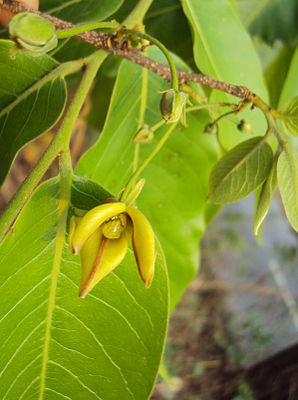Cat's claw
| Cat's claw | ||||||||||||
|---|---|---|---|---|---|---|---|---|---|---|---|---|

Cat's Claw ( Uncaria tomentosa ) |
||||||||||||
| Systematics | ||||||||||||
|
||||||||||||
| Scientific name | ||||||||||||
| Uncaria tomentosa | ||||||||||||
| ( Willd. ) DC. |
Cat's Claw ( Uncaria tomentosa ) is a plant of the genus Uncaria in the family of the Rubiaceae (Rubiaceae). It is especially known as an ingredient in medication .
The most common common names for Uncaria tomentosa in other languages are: Unha de Gato (Portuguese-speaking countries), Uña de Gato (Spanish-speaking countries), Cat's Claw (English-speaking countries), Griffe de Chat (French-speaking countries).
description
Vegetative characteristics and location
Uncaria tomentosa prefers to grow on moist, shady soil in the natural tropical rainforest , where the plants can reach a trunk diameter of up to 25 cm and a trunk length of up to 30 meters. When cultivated, however, the specimens are usually short and bushy.
The roots of Uncaria tomentosa grow horizontally at the interface between clay and loose organic material, a few centimeters below the surface. Above ground, the plant forms short shoots with oval-shaped pairs of leaves on its main shoots, which extend into the canopy of its carrier trees. In the leaf axils there are crescent-shaped, curved holding organs that are reminiscent of the shape of a cat's claw. During the flowering period, paniculate inflorescences with a yellow color take the place of the thorns.
Generative characteristics
Differences from other species
Is confused Uncaria tomentosa often with the second Uncaria -type in South America Uncaria guianensis (Aubl.) Gmel. This differs from Uncaria tomentosa morphologically in its thorn and leaf shape as well as in flower size and color. Further differences can be seen in the shape of the seeds and the seed capsule, but also in the shoot tips and other morphological details. Likewise, karyosystematic investigations show clear differences; the results of these investigations do not suggest any close relationship between Uncaria tomentosa and Uncaria guianensis . Furthermore, the two South American Uncaria differ significantly in the content and distribution of their pharmacologically active ingredients.
distribution
Uncaria tomentosa is one of the two Uncaria species found in South America . Their occurrence extends over the entire Amazon region from Bolivia , Brazil , Peru via Colombia , Ecuador , Suriname and Guiana to Panama and Puerto Rico .
Systematics
Synonyms for Uncaria tomentosa (Willd.) DC. are Nauclea tomentosa Willd., Uncaria surinamensis Miq. or Uruparia tomentosa (Willd.) O.Kuntze.
ingredients
The roots of Uncaria tomentosa contain 2–3% oxindole alkaloids . In stem and root of Uncaria tomentosa were terpenoids , in particular Quinovinsäureglykoside , Urolsäurederivate and sterols (in particular β-sitosterol ), and flavonoids such as proanthocyanidins , (-) epicatechin and Chinconaine detected.
The distribution and composition of the alkaloids in different plant populations is not homogeneous. Two chemotypes were found, of which one chemotype contains 6 pentacyclic oxindole alkaloids (pteropodin, isopteropodine, speciophylline, Uncarin F, mitraphylline, isomitraphylline), the other 4 tetracyclic oxindole alkaloids (rhynchophylline, isorhynchophylline).
pharmacology
The main action of extracts from the root and stem of Uncaria tomentosa is directed at the immune system . Pentacyclic and tetracyclic oxindole alkaloids increase the phagocytosis performance of granulocytes and macrophages , with isopteropodin having the most pronounced phagocytosis- increasing effect. These studies achieved effects comparable to other non-specific immune stimulants .
A regulatory effect on lymphocyte proliferation has also been demonstrated for the pentacyclic oxindole alkaloids (POA) . POAs induce the release of a lymphocyte growth-regulating protein from endothelial cells , which inhibits the clonal expansion of highly activated and transformed lymphocytes, but at the same time increases the proliferation of dormant and weakly activated lymphocytes. This effect is competitively antagonistically inhibited by tetracyclic oxindole alkaloids (TOA) of the second chemotype of Uncaria tomentosa .
An aqueous decoction of Uncaria tomentosa inhibits the activation of the transcription factor NF-KappaB in macrophages, which is partly responsible for the development of inflammatory processes . In addition, procyanidins and quinovinic acid glycosides showed anti-inflammatory effects in model tests . Animal experiments have shown that extracts from Uncaria tomentosa have anti-inflammatory properties.
A pronounced anti- leukemic effect was found for the pentacyclic oxindole alkaloid Uncarine F. Fractions of aqueous extracts from the stem bark of Uncaria tomentosa showed pronounced growth inhibition on human breast cell lines .
Six quinovinic acid glycosides from Uncaria tomentosa showed in-vitro antiviral properties against two RNA virus infections ( Vesicular stomatitis virus and Rhinovirus 1B ).
The intramuscular application of pentacyclic oxindole alkaloids to cats with retroviral infections , which if untreated is fatal in 90% of the cases, resulted in a regression of the disease symptoms in 85% of the test animals; 44% of the animals were virus-free after five months of observation.
Web links
- R. Länger: Uncaria tomentosa (Willd.) DC., Cat's Claw: a South American medicinal plant, scientifically researched . ( Memento from June 4, 2010 in the Internet Archive ) In: ÖAZ Aktuell , 4/2002
- R. Länger: Tyrolean study on rheumatoid drug: "Krallendorn" . ( Memento from May 20, 2007 in the Internet Archive ) In: ÖAZ Aktuell , 1/2003
- KH Reinhard: Uncaria tomentosa (Willd.) DC: cat's claw, una de gato, or saventaro. In: J Altern Complement Med. 1999, PMID 10328636 .
Individual evidence
- ↑ R. Longer: Uncaria tomentosa (Willd.) DC., Cat's Claw: a South American medicinal plant, scientifically researched . In: ÖAZ Aktuell , 4/2002.
- ^ KH Reinhard: Uncaria tomentosa (Willd.) DC .: cat's claw, una de gato, or saventaro. In: J. Altern. Complement. Med. , 1999
- ↑ C. Jaenicke, J. Gruenwald, T. Brendler: Handbuch Phytotherapie . Scientific publishing company, 2003